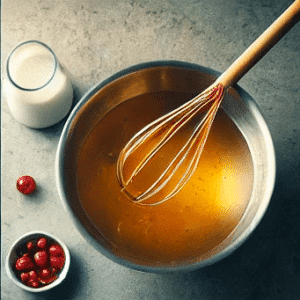Introduction
Tanghulu is the hottest sensation among Gen Z and Korean millennials right now. Several factors play a significant role in this trend’s staying power. Well, why not? We should also hop onto this trend and learn how to make tanghulu recipe.
To let you know about its basics first, it’s a shiny and enjoyable candied fruit treat that travelled specifically from Northern China. But where does it come from in Northern China? It came to Northern China from the Song dynasty, which lasted from 960 to 1279 A.D. Yep, it’s more like an ‘old is gold’ treat!
It was typically sold on the street carts of Northern China back then, but it’s been popular within China, Japan, Korea, and a couple of American cities. Tanghulu cult describes this treat as sweet, colourful, one-of-a-kind, and a resembler of jewel-like fruits. Talking about the current scenario, they’ve found an upgraded fruit version, making everyday ingredients more exciting and memorable.
Its popularity can also be determined by its search volume on various social media platforms and the expansion of the original Tanghulu chain. Korea’s Dalkom Wang Ga Tanghulu operates this original chain.
So, learning how to make Tanghulu at home will never make you feel FOMO about this trend. It’s also an investment in a nutritional diet. Let’s dig deep into our recipe tutorial below without any further delay!
What is Tanghulu?

It’s a traditional Chinese candied fruit snack known as ‘bingtang Hulu.’ It consists of rock-sugar-coated fruits, such as strawberries, oranges, cherry tomatoes, etc., stuck on a bamboo skewer.
However, Tanghulu is coated in hardened sugar syrup, unlike the regular candied fruits. Initially, Chinese hawks, grapes, or walnuts were mainly used to prepare Tanghulu recipe. It now offers diverse fruit choices, including mandarin oranges, cherry tomatoes, blueberries, strawberries, pineapple, bananas, and kiwifruit.
Ingredients and Tools Needed
Look at the following ingredients and tools needed to make its recipe.

Ingredients
Fresh fruits: It’s always best to use fruits with firm, juicy texture and tangy/sour taste to prepare Tanghulu at home. So, you can pick fruits such as grapes, strawberries, kiwi, blueberries, orange wedges slices, cherries, tangerines, pineapples, or every cherry tomato.
Granulated sugar: You can use white granulated sugar for this purpose.
Water
Optional: You can use skewers or toothpicks.
Tools
- Saucepan.
- Candy thermometer (optional but helpful).
- Baking sheet or tray.
- Parchment paper or silicone mat.
- Bowl of cold water (for candy-hardness testing)
How to Make Tanghulu Recipe at Home
Let us show you how to make this delicious treat right in your kitchen! You’ll be hooked once you try this yummy recipe.
Step 1: Preparing for the Process

Better to have everything set before you get into the sugary stuff. Wash and dry your fruits well to begin with. Get them squeaky clean! If you’re aiming for that classic Tanghulu体验, you have to skewer your fruits. And, if you like to eat them with your fingers, that’s cool as well!
Finally, place parchment paper down on your work surface and allow to cool. In preparation, gather all your ingredients and tools together in one place.
If you love experimenting with fresh and pleasant aromas in your home while cooking, check out the best air fresheners for home.
Step 2: Make the Candy Syrup

Now let’s prepare Tanghulu’s candy coating! In a saucepan, combine the sugar and water. The exact ratio can differ, but a good place to start is two parts sugar to 1 part water. Begin heating this all over medium heat while stirring until the sugar completely dissolves.
Let the syrup simmer until it reaches the “hard crack” stage, which is around 300°F (149°C). Wondering how to make Tanghulu without a candy thermometer? No problem. You can test it by carefully dropping a dab of syrup into cold water. If it forms stiff, brittle threads, you’re good to go.
Step 3: Coat the Fruits

Take it off the heat once the syrup is ready. Then, quickly dip each fruit into the syrup and ensure it becomes a fully sugar coated fruit. Let the excess syrup drip off, then place the fruit on your prepared parchment paper.
Step 4: Cooling & Serving

The last step is to let your Tanghulu cool completely on the parchment paper. This is when that satisfying candy shell forms. They’re ready to eat once they’re hardened. Serve them up and watch them disappear!
Tips & Tricks
- If you’re learning how to make Tanghulu fruit, make sure to work fast while coating the fruits.
- The syrup will start to cool and thicken quickly once it’s off the heat. If it begins to crystallize, just add a sprinkle of water and reheat it.
- You can also try other types of fruits—strawberries are classic, but grapes, mandarin oranges, or even kiwi slices work great too!
If you enjoy bright and aesthetically pleasing foods, you might love these pink flowers to enhance your home decor or garden!
Common Mistakes to Avoid
- Overheating the syrup can lead to a burnt state.
- Excess water can prevent the candy sugar-covered fruit from sticking if you don’t dry the fruit properly.
- If you use too ripe fruits, they might fall apart when dipped in the syrup.
Storage Tips
Storing Tanghulu at Room Temperature
If you plan to eat Tanghulu on the same day, store it at room temperature to keep it crunchy.
- You can use an airtight container to remove the moisture and prevent the sugar shell from turning sticky.
- Pick a cool, dry spot to keep it. Avoid direct sunlight or heat. A pantry or countertop works well as long as the temperature stays steady.
- Tanghulu can last 6-8 hours, but it’s best to eat it sooner. Humidity can soften the sugar over time.
Refrigerating Tanghulu
If you’re figuring out how to make tanghulu and want to store it for longer, refrigeration is a good option. Just be sure to protect it from fridge moisture, which can ruin the candy shell.
- Use wax or parchment paper to wrap each tanghulu before placing it in the fridge. This helps prevent moisture from forming on the sugar.
- After wrapping, put this candy coated fruit in a dry, sealed container to keep out moisture.
- Refrigeration can help for 1-2 days, but it’s best to eat it sooner. The sugar may soften a bit, but the fruit will stay fresh.
Freezing Tanghulu
Freezing tanghulu works well for long storage, but it will change the texture of the candy and fruit.
- Use wax or parchment paper to wrap each tanghulu. This prevents freezer burn and keeps moisture away.
- Put the wrapped Tanghulu in an airtight container or zip-lock bag. Remove as much air as possible before sealing.
- You can freeze it for several weeks. The fruit will stay fresh, but the sugar may lose its crunch after thawing.
- Let frozen tanghulu sit at room temperature for 15-20 minutes before eating. Thawing in the fridge can cause moisture and make it sticky.
If you’re interested in expanding your kitchen skills, you might also want to explore how to cook butternut squash. Now, let’s dig deep into our recipe tutorial below without any further delay!
Conclusions
Learning how to make tanghulu at home is such a fun and rewarding experience. It’s simple enough for anyone to do, but the results are both yummy and impressive! The trick is to get creative with your fruits or mix some food coloring into the syrup for a rainbow effect. Whether you’re making them for a party or a special treat, it’s guaranteed to bring smiles all around. So, go on, give it a try!
FAQs
How to make tanga lulu?
Tanghulu (sometimes known as ‘tanga lulu’) is made by coating fruits in a hard candy shell. You can follow the steps given above to create this delicious treat at home!
What is the ratio of sugar to water for Tanghulu?
A good starting point is two parts sugar to 1 part water. For instance, you could use 2 cups of sugar and 1 cup of water.
What is Tanghulu traditionally made of?
Tanghulu is traditionally or originally made with hawthorn berries. Yet, other fruits such as strawberries, mandarin oranges, and other fancy fruits are popular modern alternatives.
How Much Water and Sugar for Tanghulu?
You can try 1 cup of sugar and ½ cup of water to prepare a small batch of Tanghulu. Adjust the quantities based on how many fruits you want to coat.
How to Make Tanghulu in the Microwave?
While making candy syrup in the microwave is possible, controlling the temperature is tricky. However, you can use the stovetop method described above for best results.
Why is my tanghulu not hardening?
The syrup wouldn’t reach a high enough temperature if your Tanghulu hadn’t been hardening. Yet, you can ensure it is heated to the hard crack stage, i.e., 300°F.
What are the best fruits to use for Tanghulu?
Strawberries are popular, but you can also try grapes, cherries, mandarin orange segments, or even apple slices.
Why isn’t my candy syrup sticking to the fruit?
This could be because your fruit is too wet or your syrup has cooled too much. Dry your fruit thoroughly and work fast with the hot syrup.
How long does Tanghulu stay fresh?
Tanghulu is best eaten within 24 hours. The candy coating may start to get sticky or melt after that.
Can I make Tanghulu without a candy thermometer?
Yes, you can do so with a ‘cold water test.’ You just need to take a bowl of cold water and drop some candy syrup. Tanghulu is ready to proceed if it forms hard, brittle threads that will snap easily.
Is Tanghulu safe for kids to eat?
While Tanghulu is generally safe for kids, be cautious when preparing hot syrup. The finished product can be challenging, so supervise young children when eating

